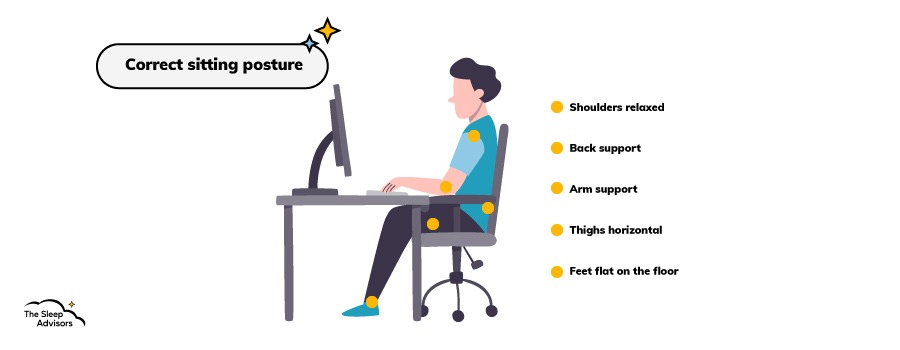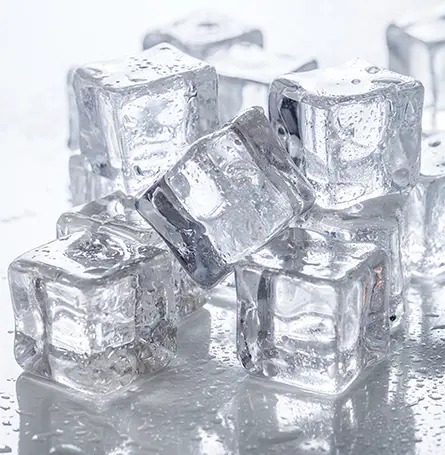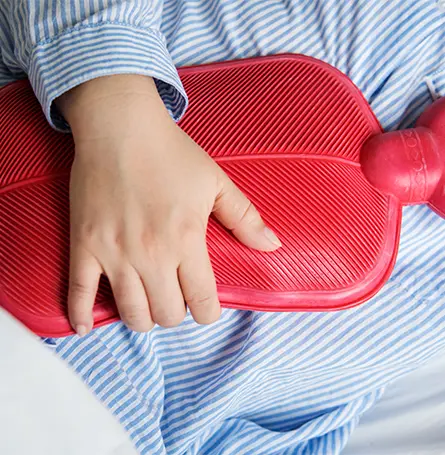The most common causes of upper left back pain
The two most common causes of back pain are simple muscle injuries and poor posture. So, we're going to go over those possibilities first. However, it's worth noting that these kinds of pain are usually acute, meaning that they shouldn't last for more than a few days.
In other words, if you're experiencing chronic pain, it might be more serious. And while we will discuss more severe injuries and conditions later on, make sure you book an appointment with your doctor.
Muscle strain

As we've mentioned, most of the time, a simple muscle injury could be behind your back pain. And, considering that multiple muscle groups converge in the upper back, it's likely that one of them has been strained.
So, let's quickly go over the three muscle groups that can cause pain in the upper back and describe how they could have potentially been strained.
Rear deltoid
While most people think of shoulder muscles as being “front-facing”, they actually stretch into the upper back as well. And since they don't get as much attention as the front or side deltoid, the rear deltoids could be more susceptible to strain.
So, if you've been going to the gym, swimming, or playing a sport like baseball, your deltoids could be causing minor upper back pain.
Trapezius
The trapezius (or the traps) is a muscle that runs from the sides of your neck to your upper back. And a strain in this muscle could result in neck pain as well as upper back pain. Just like the rear deltoid, this muscle isn't as “popular” as the bicep or the chest, meaning that it often gets underworked.
Thus, if you were doing a pulling motion and lifted your shoulder up, the muscle could have taken on the brunt of the force. However, the pain typically isn't too bad and should go away after a few days.
That is unless the stress on the muscle is more severe and consistent, in which case you could develop Trapezius Myalgia. If that happens, you might need to see a physical therapist for proper pain relief.
Other upper back muscles
Lastly, we have the bigger muscle groups that are a bit more “used to” physical strain. If you have pain between your shoulder blades, it could be a strain on your rhomboids, as they connect your scapula to the spine.
If it's at the side of your neck, it could also be the Levator scapulae. And if your pain is more towards the chest, like under your armpit, you could have pulled your Latissimus dorsi or lats.
Poor posture

It's no secret that most people tend to hunch over while at their desks or at home.
And while this shouldn't lead to any issues in the short term, it does put stress on your upper back muscles and neck.
So, like with muscle overuse, your upper back pain could be caused by prolonged stress on these muscles. In very drastic cases, this can even lead to kyphosis.
Likewise, if you tend to bend to one side, you could develop pain in your upper right or upper left abdomen.
And over time, this could lead to scoliosis.
With all of that being said, we don't expect you to sit with perfect posture at every waking minute.
Just take a look at the graph below and do your best to sit up straight as often as you can.

Injuries and conditions that can cause upper back pain

If the muscles in your upper back are completely fine and you regularly balance books on your head, the cause of your upper back pain could be a bit more serious.
Namely, there are plenty of injuries and conditions that can cause this type of pain as your shoulder blades, spinal cord, discs, and the soft tissue that surrounds them can all be affected.
In other words, you might experience sharp pain as well as other symptoms and it might even constitute a medical emergency.
So, make sure to talk to your GP.
A herniated disc
Discs are like little pillows that go in between the vertebrae in your spine and act like shock absorbers. However, your discs degenerate over time and can even rupture or dislocate. This is how you get a herniated disc.
And depending on the position of the disc and whether it's pressing down on nerves in your spine, you can experience minor to severe back pain as a result. This is more common in older individuals but it can happen to anyone due to a large amount of strain or an injury.
Luckily, a herniated disc usually doesn't require surgery to make the pain go away. Talk to your doctor about getting prescription pain medication, avoid lying in bed too much, and there's a chance your body will manage to heal. However, if there are other pain symptoms or complications, seek medical treatment.
This is because if the nerves inside the spinal canal do get pinched (Foraminal stenosis), you might be in more pain and need immediate medical attention.
Vertebral compression fracture
On a similar note, if one or multiple of your vertebrae get damaged, it's likely going to result in back pain. This is especially common in people with Osteoporosis, as it takes a lot less force to cause damage to the vertebrae.
With that being said, these kinds of fractures are more common in your thoracic spine (the middle of your back) than your upper back. It's still possible but if you don't suffer from Osteoporosis and haven't had any sort of injury recently, it's not as likely.
Heart issues
While it usually doesn't make too much of a difference whether it's upper left or upper right side back pain, there is one key exception – your heart.
And you'll see that heart attack symptoms can easily be mistaken for upper back pain symptoms. According to the CDC, heart attack symptoms can cover both chest pain as well as discomfort or back pain. So, if you're experiencing upper back pain between your shoulder blades and your chest, it could be a cause for concern.
Of course, when it comes to heart issues, things such as your and your family's medical history are very important. And certain habits like smoking or living a sedentary lifestyle can contribute.
Lung cancer
Lastly, some types of cancers, like lung cancer, can cause back or hip pain. However, in these cases, there are usually other symptoms. So, unless you're also experiencing chest pain or shortness of breath, and are coughing up some blood, we wouldn't recommend immediately jumping to conclusions.
If you are a smoker or have a history of lung issues, we recommend seeing your GP and discussing the matter further with them.
How to relieve back pain
Now that you have an idea of how to identify what is causing your back pain, let's talk about how you can potentially dampen it. Of course, for serious injuries and medical conditions, you will need to see a doctor. However, for muscle strain and minor injuries, you might be able to sleep it off.
So, let's go over a few of the most common ways you can relieve pain or prevent it from happening in the future.
Ice packs

Cold therapy is generally useful during the first 72 hours when you experience muscle spasms.
So, if you have upper back spasms, try using some frozen vegetables or an ice pack and applying it to the affected spot for up to 20 minutes a few times a day.
Cold therapy has also been shown to decrease general muscle pain by constricting the blood flow in the affected area.
So, if you were wondering how to relieve upper back and chest pain as well, cold therapy could be a solid option.
However, we will note that cold therapy is said to be more effective for old injuries.
When it comes to new sources of pain, some professionals recommend heat therapy instead.
Heat packs

If you're experiencing muscle soreness after an intense back workout, heat therapy could be the way to go.
If you were wondering how to relieve pain between your shoulder blades, this could be a good option as your rhomboids could just be sore.
Heat therapy is also good for chronic muscle pain as well as pain caused by arthritis.
So, whether you want to relax the muscles in your upper back or even give your bones some relief, heat therapy could be useful.
With that being said, make sure you have a sore upper back and not a serious injury.
Stay active
This might seem a bit counterintuitive as we've just talked about hot and cold packs and how they can help you after overusing your muscles. However, staying active is one of the best ways to avoid having back pain.
For one, being overweight puts excess pressure on your back. Secondly, by strengthening your back muscles, you'll be less likely to injure yourself when you have to pick something off the ground.
Just make sure not to lift with your ego. Proper form should be your number one priority, not impressing other people at the gym. And make sure you allow your muscles time to rest and rebuild, taking rest days at least 3 times a week.
Anti-inflammatory medication
If you're experiencing intense pain at night and can't fall asleep because of it, getting anti-inflammatory medication could be your best option. NSAIDs are especially useful when it comes to sprains, stains, and conditions such as arthritis.
Also, it's important to keep in mind that NSAIDs can become addictive. So, make sure to consult your doctor and not go over the recommended dosage even if the pain doesn't completely go away.
Swap out your bedding
While a mattress can cause back pain, it's usually felt in your lower back. This is because if you don't choose the correct mattress, your hips can sink into the mattress, leaving your spine bent during the night.
However, if you have pain at the top of your spine, it could be your pillow's fault. This is because if you sleep on your side and have a pillow that's too big or too small, your head will bend to the side. This will in turn put pressure on your neck and potentially even your spine.
So, if you have neck and back pain, it's worth learning how to choose the correct pillow and retiring your old one.
Conclusion
Overall, back pain can be caused by a lot of different factors – from muscle strain to arthritis and even a pillow that's just a bit too big. So, even if the pain is localised in just your upper left back, it can be difficult to gauge exactly what's causing it.
However, we hope that you now know the most common causes of upper left back pain and can determine your next step confidently. And if you're not 100% certain, just go to your doctor and have a check-up.














There are no comments yet
"*" indicates required fields